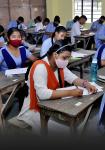Part 1: Quota: Just how many OBCs are there?
Schedule Castes and Schedule Tribes, along with Other Backward Classes, together comprise around two-thirds of the country's working population, according to the National Sample Survey's 1999-2000 round. This is roughly in step with their share of the population as well.
The share of SC/STs and OBCs in jobs defined by the NSS as "professional, technical and managerial" (the top jobs in the economy) is a lower 38 per cent - the "professional, technical and managerial" group comprises 7 per cent of the total jobs in the country. In the case of "clerical and sales" jobs, the share of these two groups is 44 per cent.
The shortfall, relative to population share, is greater in the case of SC/STs compared with the OBCs. The share of SC/STs in "professional" jobs is 14.3 per cent and their population share is 28.3. This works out to a ratio of around 50. But for OBCs, this ratio is a healthier 67.
If the educational qualifications of SC/STs and OBCs are taken into account, the shortfall does not look so evident anymore. Just 15.1 per cent of those enrolled in colleges in 1999-2000, for instance, were SC/STs - which is why the SC/ST share in the "professional" jobs category cannot be much higher than it already is, that is, 14.3 per cent.
Similarly, in the case of OBCs, they comprised 23.3 per cent of those enrolled in colleges in 1999, and their share in "professional" jobs in that year was also similar - 24.2 per cent.
"It is obvious that a long-term solution lies in improving schooling," says Yogendra Yadav, professor at the Delhi-based Centre for the Study of Developing Societies.
"But saying this means there should be no quotas and is akin to saying you do not need immunisation since the key to better health lies in better nutrition," he adds.
A complicating factor noted by Yadav is that, according to him, not all in the SC/ST and OBC categories that are graduating are getting employed.
Not correct, according to NSS data. In the case of SC/STs, even without job reservation, there is little evidence of discrimination.
Unemployment rates for this category fell by around 29 per cent between 1983 and 1993-94 (from 4.8 per cent to 3.4 per cent), compared with a smaller fall of 14 per cent for upper caste Hindus (from 4.3 per cent to 3.7 per cent).
Between 1993-94 and 1999-2000, unemployment for SC/STs rose by 15 per cent (from 3.4 per cent to 4 per cent) while that for upper caste Hindus rose by a higher 24 per cent (from 3.7 per cent to 4.6 per cent). During this period, the share of SC/STs in "professional" jobs rose from 11.6 per cent in 1983 to 14.3 per cent in 1999-00.
There is no time series data for OBCs since the first time they were canvassed as OBCs was during the 1999-2000 NSS round. But the unemployment rate for this category in 1999-2000 was 3.5 per cent, a figure that was lower, by a significant margin, than that for any other social group.






 © 2025
© 2025